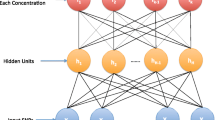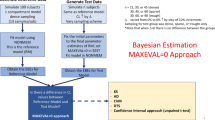Abstract
Genetic data is now collected in many clinical trials, especially in population pharmacokinetic studies. There is no consensus on methods to test the association between pharmacokinetics and genetic covariates. We performed a simulation study inspired by real clinical trials, using the pharmacokinetics (PK) of a compound under development having a nonlinear bioavailability along with genotypes for 176 single nucleotide polymorphisms (SNPs). Scenarios included 78 subjects extensively sampled (16 observations per subject) to simulate a phase I study, or 384 subjects with the same rich design. Under the alternative hypothesis (H1), six SNPs were drawn randomly to affect the log-clearance under an additive linear model. For each scenario, 200 PK data sets were simulated under the null hypothesis (no gene effect) and H1. We compared 16 combinations of four association tests, a stepwise procedure and three penalised regressions (ridge regression, Lasso, HyperLasso), applied to four pharmacokinetic phenotypes, two observed concentrations, area under the curve estimated by noncompartmental analysis and model-based clearance. The different combinations were compared in terms of true and false positives and probability to detect the genetic effects. In presence of nonlinearity and/or variability in bioavailability, model-based phenotype allowed a higher probability to detect the SNPs than other phenotypes. In a realistic setting with a limited number of subjects, all methods showed a low ability to detect genetic effects. Ridge regression had the best probability to detect SNPs, but also a higher number of false positives. No association test showed a much higher power than the others.





Similar content being viewed by others
Abbreviations
- FWER:
-
Family wise error rate
- LOQ:
-
Limit of quantification
- NCA:
-
Noncompartmental analysis
- NLMEM:
-
Nonlinear mixed effects model
- PK:
-
Pharmacokinetics
- SNP:
-
Single nucleotide polymorphism
- α:
-
Type I error
- β:
-
Effect size coefficient
- λ, γ, ξ:
-
Penalisation parameters
References
Aarons L. Population pharmacokinetics: theory and practice. Br J Clin Pharmacol. 1991;32(6):669–70.
Motulsky AG. Drugs and genes. Ann Intern Med. 1969;70(6):1269–72.
Motulsky AG, Qi M. Pharmacogenetics, pharmacogenomics and ecogenetics. J Zhejiang Univ Sci B. 2006;7(2):169–70.
Rowland M, Tozer T. Clinical pharmacokinetics: concepts and applications. Baltimore: Lippincott Williams & Wilkins; 1995.
Gabrielson J, Weiner D. Pharmacokinetic and pharmacodynamic data analysis, concepts and applications. 4th ed. Sweden: Swedish Pharmaceutical Press; 2007.
Sheiner LB, Rosenberg B, Melmon KL. Modelling of individual pharmacokinetics for computer-aided drug dosage. Comput Biomed Res Int J. 1972;5(5):411–59.
Sheiner LB, Steimer JL. Pharmacokinetic/pharmacodynamic modeling in drug development. Annu Rev Pharmacol Toxicol. 2000;40:67–95.
Shalon D, Smith SJ, Brown PO. A DNA microarray system for analyzing complex DNA samples using two-color fluorescent probe hybridization. Genome Res. 1996;6(7):639–45.
Daly MJ, Rioux JD, Schaffner SF, Hudson TJ, Lander ES. High-resolution haplotype structure in the human genome. Nat Genet. 2001;29(2):229–32.
EMA. Guideline on the use of pharmacogenetic methodologies in the pharmacokinetic evaluation of medicinal products. 2012. Report No.: EMA/CHMP/37646/2009.
FDA. Guidance for Industry and FDA Staff: Pharmacogenetic Tests and Genetic Tests for Heritable Markers. 2007.
Omoyinmi E, Forabosco P, Hamaoui R, Bryant A, Hinks A, Ursu S, et al. Association of the IL-10 gene family locus on chromosome 1 with juvenile idiopathic arthritis (JIA). PLoS One. 2012;7(10):e47673.
Yao T-C, Du G, Han L, Sun Y, Hu D, Yang JJ, et al. Genome-wide association study of lung function phenotypes in a founder population. J Allergy Clin Immunol. 2014;133(1):248–55.e1-10.
Hoerl AE, Kennard RW. Ridge regression: biased estimation for nonorthogonal problems. Technometrics. 1970;12(1):55.
Cule E, Vineis P, De Iorio M. Significance testing in ridge regression for genetic data. BMC Bioinformatics. 2011;12:372.
Tibshirani R. Regression shrinkage and selection via the lasso. J R Stat Soc Ser B. 1994;58:267–88.
Hoggart CJ, Whittaker JC, De Iorio M, Balding DJ. Simultaneous analysis of all SNPs in genome-wide and re-sequencing association studies. PLoS Genet. 2008;4(7):e1000130.
Jaki T, Wolfsegger MJ. Estimation of pharmacokinetic parameters with the R package PK. Pharm Stat. 2011;10(3):284–8.
Dubois A, Bertrand J, Mentre F. Mathematical expressions of the pharmacokinetic and pharmacodynamic models implemented in the PFIM software. 2011. http://www.pfim.biostat.fr/.
Duffull SB, Graham G, Mengersen K, Eccleston J. Evaluation of the pre-posterior distribution of optimized sampling times for the design of pharmacokinetic studies. J Biopharm Stat. 2012;22(1):16–29.
Cule E, De Iorio M. Ridge regression in prediction problems: automatic choice of the ridge parameter. Genet Epidemiol. 2013;37(7):704–14.
Vignal CM, Bansal AT, Balding DJ. Using penalised logistic regression to fine map HLA variants for rheumatoid arthritis. Ann Hum Genet. 2011;75(6):655–64.
Gradshteyn I, Ryzik I. Tables of integrals, series and products: corrected and enlarged edition. New York: Academic; 1980.
Lehr T, Schaefer H-G, Staab A. Integration of high-throughput genotyping data into pharmacometric analyses using nonlinear mixed effects modeling. Pharmacogenet Genomics. 2010;20(7):442–50.
Su Z, Marchini J, Donnelly P. HAPGEN2: simulation of multiple disease SNPs. Bioinforma Oxf Engl. 2011;27(16):2304–5.
International HapMap Consortium. The International HapMap Project. Nature. 2003;426(6968):789–96.
Lavielle M, Mesa H, Chatel K. The MONOLIX software. 2010. http://www.lixoft.eu/.
Kuhn E, Lavielle M. Coupling a stochastic approximation version of EM with an MCMC procedure. ESAIM Probab Stat. 2004;8:115–31.
Takeuchi F, McGinnis R, Bourgeois S, Barnes C, Eriksson N, Soranzo N, et al. A genome- wide association study confirms VKORC1, CYP2C9, and CYP4F2 as principal genetic determinants of warfarin dose. PLoS Genet. 2009;5(3):e1000433.
Cochran WG. The comparison of percentages in matched samples. Biometrika. 1950;37(3–4):256–66.
Bertrand J, Bading D, De Iorio M. Penalized regression implementation within the SAEM algorithm to advance high-throughput personalized drug therapy. 22th PAGE Meet Glasg Scotl. 2013;Abstract 2932.
Zou H, Hastie T. Regularization and variable selection via the elastic net. J R Stat Soc Ser B Stat Methodol. 2005;67(2):301–20.
Lockhart R, Taylor J, Tibshirani RJ, Tibshirani R. A significance test for the lasso. Ann Stat. 2014;42(2):413–68.
Knights J, Chanda P, Sato Y, Kaniwa N, Saito Y, Ueno H, et al. Vertical integration of pharmacogenetics in population PK/PD modeling: a novel information theoretic method. CPT Pharmacomet Syst Pharmacol. 2013;2(2):e25.
O’Hara RB, Sillanpaa MJ. A review of Bayesian variable selection methods: what, how and which. Bayesian Anal. 2009;4(1):85–117.
Bertrand J, Comets E, Mentre F. Comparison of model-based tests and selection strategies to detect genetic polymorphisms influencing pharmacokinetic parameters. J Biopharm Stat. 2008;18(6):1084–102.
Bertrand J, Comets E, Laffont CM, Chenel M, Mentre F. Pharmacogenetics and population pharmacokinetics: impact of the design on three tests using the SAEM algorithm. J Pharmacokinet Pharmacodyn. 2009;36(4):317–39.
Bertrand J, Comets E, Chenel M, Mentre F. Some alternatives to asymptotic tests for the analysis of pharmacogenetic data using nonlinear mixed effects models. Biometrics. 2012;68(1):146–55.
Bertrand J, Balding DJ. Multiple single nucleotide polymorphism analysis using penalized regression in nonlinear mixed-effect pharmacokinetic models. Pharmacogenet Genomics. 2013;23(3):167–74.
Ribbing J, Nyberg J, Caster O, Jonsson EN. The lasso—a novel method for predictive covariate model building in nonlinear mixed effects models. J Pharmacokinet Pharmacodyn. 2007;34(4):485–517.
Dubois A, Gsteiger S, Pigeolet E, Mentre F. Bioequivalence tests based on individual estimates using non-compartmental or model-based analyses: evaluation of estimates of sample means and type I error for different designs. Pharm Res. 2010;27(1):92–104.
Panhard X, Mentre F. Evaluation by simulation of tests based on non-linear mixed- effects models in pharmacokinetic interaction and bioequivalence cross-over trials. Stat Med. 2005;24(10):1509–24.
Humbert H, Cabiac MD, Barradas J, Gerbeau C. Evaluation of pharmacokinetic studies: is it useful to take into account concentrations below the limit of quantification? Pharm Res. 1996;13(6):839–45.
Ahn JE, Karlsson MO, Dunne A, Ludden TM. Likelihood based approaches to handling data below the quantification limit using NONMEM VI. J Pharmacokinet Pharmacodyn. 2008;35(4):401–21.
Savic RM, Karlsson MO. Importance of shrinkage in empirical bayes estimates for diagnostics: problems and solutions. AAPS J. 2009;11(3):558–69.
Acknowledgments
Adrien Tessier received funding from Institut de Recherches Internationales Servier. The authors thank Laurent Ripoll and Bernard Walther from Institut de Recherches Internationales Servier for their advices in pharmacogenetics. The authors would also like to thank Herve Le Nagard for the use of the computer cluster services hosted on the “Centre de Biomodélisation UMR1137”.
Author information
Authors and Affiliations
Corresponding author
Electronic supplementary material
Below is the link to the electronic supplementary material.
Supplementary materials
(PDF 373 kb)
Simulated polymorphisms informations
(PDF 656 kb)
Rights and permissions
About this article
Cite this article
Tessier, A., Bertrand, J., Chenel, M. et al. Comparison of Nonlinear Mixed Effects Models and Noncompartmental Approaches in Detecting Pharmacogenetic Covariates. AAPS J 17, 597–608 (2015). https://doi.org/10.1208/s12248-015-9726-8
Received:
Accepted:
Published:
Issue Date:
DOI: https://doi.org/10.1208/s12248-015-9726-8




